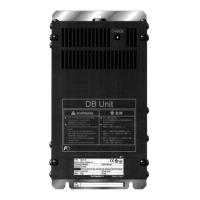7.3 Periodic Inspection
7-4
7.3.2 Periodic inspection 2--When the inverter is ON or it is running
Visually inspect the inverter for operation errors from the outside without removing the covers when the inverter is
ON or it is running.
Perform periodic inspections according to the items listed in Table 7.3-2
Table 7.3-2 Periodic Inspection List 2
Check part Check item How to inspect Evaluation criteria
Input voltage Check that the input voltages of the
main and control circuits are correct.
Measure the input
using a multimeter or the
like.
The standard
specifications must be
satisfied.
Structure such as
chassis and
covers
Check for abnormal noise or excessive
vibration when the inverter is running.
Visual and auditory
inspections
No abnormalities
Main circuit
Transformer
s and
reactors
Check for abnormal roaring noise or
odor when the inverter is running.
Auditory, visual, and
olfactory inspections
No abnormalities
Magnetic
contactors
and relays
Check for chatters when the inverter is
running.
Auditory inspection No abnormalities
DC link bus
capacitor
Measure the capacitance if necessary.
Judgment on service life
using “Menu #5
Maintenance Information
(
%che
)” in Chapter 3,
Section 3.4.5.
Capacitance ≥
Initial value x 0.85
Cooling fans Check for abnormal noise or excessive
vibration when the inverter is running.
Visual and auditory
inspections
No abnormalities
Additional notes
(1) The inspection interval (every year) of check items given in Table 7.3-1 and Table 7.3-2 is merely a guide.
Make the interval shorter depending on the usage environment.
(2) Store and organize the inspection results to utilize them as a guide for operation and maintenance of the
equipment and service life estimation.
(3) At the time of an inspection, check the cumulative run times on the keypad to utilize them as a guide for
replacement of parts. Refer to “7.4.1 Judgment on service life”.
(4) The inverter has cooling fans inside to ventilate itself for discharging the heat generated by the power
converter section. This will accumulate dust or dirt on the heat sink depending on the ambient environment.
In a dusty environment, the heat sink requires cleaning in a shorter interval than that specified in periodic
inspection. Neglecting cleaning of the heat sink can rise its temperature, activating protective circuits to lead
to an abrupt shutdown or causing the temperature rise of the surrounding electronic devices to adversely
affect their service life.

